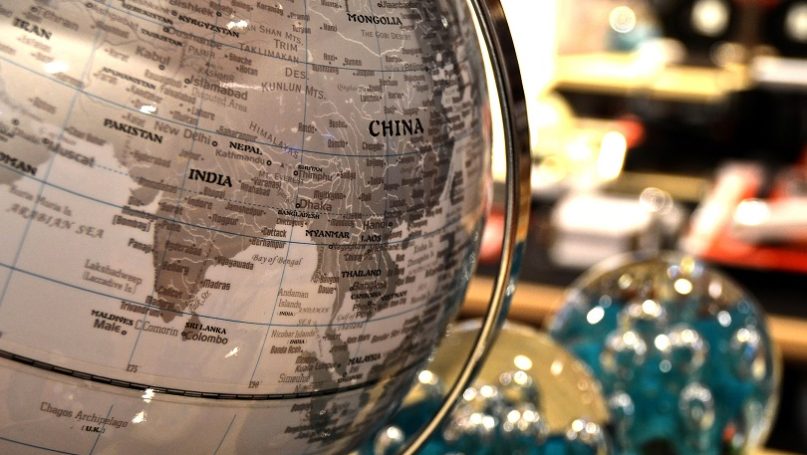
Art by Nick Roney
People who detest Donald Trump as the demon king of American politics are hoping that the feeble Republican performance in the midterm elections will weaken or dethrone him.
Democrats successfully characterised the “Make America Great Again” (Maga), Trump-dominated Republicans as a threat to democracy in the eyes of many voters. Not for nothing did the Democratic Party funnel money in some cases to the primary campaigns of extreme Maga supporters to ensure that they became the Republican candidates. But they could probably have saved themselves the money, because the Trumpian version of the Republican Party has put down deep roots.
The Republicans may have the worst of all possible worlds: a Trump too powerful to displace as party leader because he has the support of party activists; but, come election day, a leader who alienates more voters than he attracts, and is becoming an in-house political Jonah, ensuring the Republicans’ continued under-performance in future elections.
Control of the Senate
Republican leaders are understandably on tenterhooks to see whether Trump’s promised “big announcement” on 15 November will be to declare his candidacy for the Republican presidential nomination in 2024. Many counsel delay, arguing that Trump as a candidate will damage their chances in the crucial run-off for a Georgia Senate seaton 6 December, which may decide control of the Senate.
Possibly, Trump will not want to risk being labelled an election loser once again, but a delay would be a tacit admission that he is an electoral liability. A delay would also undermine his tried-and-tested method of dealing with failure or defeat, which is simply to deny that they have taken place. Brazenly preparing the ground for this tactic prior to the election, he said: “I think if [the Republicans] win, I should get all the credit. And if they lose, I should not be blamed.”
He may well get away with this among his core supporters, since he long ago persuaded them – despite a complete lack of evidence – that he was robbed of the presidency by electoral fraud in 2020.
Trump is not entirely wrong
Yet Trump is not entirely wrong in denying responsibility for the failure of the “Red Wave” to rise above a ripple. Abortion, not Trump, was the main issue for 27 per cent of voters and these broke three-to-one in favour of the Democrats, according to the exit poll. Sixty per cent of voters believe abortion should be legal, but 89 per cent of those who want it to be illegal are Republicans. More than half of Americans believe immigrants help the country, but 83 per cent of those who do not are Republicans. Similar deep divisions exist over gun control and climate change.
In other words, Trump expresses the views of a large majority of Republican voters – but a minority of voters in America as a whole.
The glee with which Trump’s enemies have focused on his latest discomfiture is partially the result of wishful thinking. His track record is of surviving setbacks and scandals that would have sunk any other politician. Many Democrats in 2016 waited for him to self-destruct and instead saw him win the White House. His verbal complicity in the 6 January Capitol riot damaged him, but largely among Americans who would not have voted for him anyway.
Covert enemies
As regards Trump’s survivability, I am reminded of the words of Conor Cruise O’Brien about Charles Haughey, an Irish political leader notorious for rising from what had been billed as his political grave: “If I saw Mr Haughey buried at midnight at a crossroad, with a stake driven through his heart – politically speaking – I should continue to wear a clove of garlic round my neck, just in case.”
Republicans and Democrats are nowhere near writing Trump’s political obituary, since his electoral wounds are not mortal. His many covert enemies among Republican Party leaders will be nervous of putting their heads above the parapet and will most likely wait until next year before seeking the nomination. Trump has already shown that he will ferociously attack any would-be rival, such as Florida governor Ron DeSantis, who cruised to re-election by a 20 per cent margin this week, and about whom Trump says that he knows dark secrets.
His Republican rivals know that opposing Trump unsuccessfully might terminate their careers, as critics of his role in the Capitol Hill riot have learnt to their cost.
A ‘cunning nutter’
The sigh of relief in London and most other European capitals over the underwhelming performance of the Republicans last week may therefore be premature. Non-Americans have tended to underestimate Trump as a politician since they became aware of him in 2016. Crazed and bizarre he may appear to be, but, says one former aide, he is a “cunning nutter.”
The midterms did not go the way Trump wanted, but they have once again made him the centre of media attention. The questions of whether he will or won’t stand again for the presidency is now being asked on every television screen in America and around the world.
Even Republicans unsympathetic to Trump think that reports of his political decline are premature. “All of these Republican power brokers and donors and thinkers and talkers, for seven years they’ve wanted to be rid of Trump, but they never do, and they’ve never said anything,” former Illinois Congressman Joe Walsh, who unsuccessfully challenged Trump for the Republican presidential nomination in 2020, told the online magazine Politico. “Now they’re hoping, ‘Oh, my God, a miserable midterm and Ron DeSantis had a great night, this will finally take him out.’ It’s wishful thinking, it’s bullshit.”
Only time will tell, since one of the problems of American election reporting is that it often takes days, even weeks, for the most crucial races to be decided.
Clutch their clove of garlic
One veteran American political expert said last Tuesday that she would be watching a film and not the first election returns because all the important news would come later. We still do not know for certainty at the time of writing who will control Congress, with the Senate tipping towards the Democrats and the House tipping rather more decisively towards the Republicans.
Supposing these expectations are fulfilled, what does the future hold for American politics? Gridlock on legislation and furious Republican inquiries into supposed Democratic crimes, certainly. If Trump stands for the presidency – and that is not a certainty – then Democrats can look forward to Republican fratricidal strife.
Even with a Republican majority in the House, they will be vulnerable to a mutinous far-right faction – a situation not so different from the Tory Party in the House of Commons.
As for Trump, he certainly has been hurt by the outcome of the midterm elections, but even those Republicans who think this damage is serious and permanent would be wise to clutch their clove of garlic for safety’s sake.
Cockburn’s Picks
Media outlets have been publishing lists of winners and losers in the midterm elections. Most of their picks are obvious, but almost nobody has pointed to one embattled group that will have been watching the results with special attention: the American wolf population.
Republican Congresswoman Lauren Boebert, who sought to delist wolves as an endangered species requiring federal protection, was at one point poised to lose a knife-edge election in Colorado. In one much watched video earlier this year, she jokes with an audience about shooting wolf puppies with her Glock firearm to make fur hats out of them. Sadly, she had regained a narrow lead at the time of writing. Howl.
Patrick Cockburn is the author of War in the Age of Trump (Verso).
BY SONALI KOLHATKAR
NOVEMBER 14, 2022
Facebook
Americans invested in the idea of living in a democracy heaved a collective sigh of relief the day after the 2022 midterm elections when it became clear that the dire predictions of a Republican sweep were overblown. Democrats made greater gains than expected, winning races in both the Senate and the House that they didn’t expect to.
It happened because masses of people cast ballots, defying long-standing historical trends of low midterm turnout. Voters almost matched the high turnout of the 2018 elections when outrage over Donald Trump’s first two years in office pushed Congress into the hands of Democrats. Stung by their opposition’s showing and by Trump’s reelection loss two years later, Republicans ramped up voter suppression efforts, hoping to blunt the impact of an increasingly young, diverse, and enthusiastic electorate.
Liberal-leaning voters showed up to the polls during this latest midterm election largely in response to the overturning of abortion rights, but also to stave off right-wing extremism.
Although the worst did not come to pass during the midterms, simply holding the line against a descent into fascism is not enough. Republicans are wresting control of the nation’s steering wheel as hard as they can and forcing it as far right as possible. Their party has divested itself from democratic norms and thrown its weight behind Trump and his lies. They have invested in stripping people of their bodily autonomy and fashioning a dangerous world ruled by force and a riotous mob mentality. Much more is needed in the face of such hubris: Fascists need to be placed on the defensive, and a split Congress is not enough to do so.
Three major factors explain why Democrats didn’t win outright control of both congressional chambers: First, Republicans have aggressively reduced the impact of Democratic votes; second, Democrats were unable or unwilling to articulate a clear message of why their agenda is better than that of the Republicans; and third, the corporate media refused to center people’s well-being in their framing of election-related issues.
Republicans have played the long game on suppressing democracy, redrawing district maps for years in order to favor their candidates and appointing conservative, partisan judges into federal courts to affirm those maps. They have done so in tandem with a slew of voter suppression laws in states they control—which is the majority. Analilia Mejia, co-executive director of the Center for Popular Democracy Action, says in an interview that such efforts are “a strategy utilized to negate the power of a rising Black and Brown electorate.”
The GOP is also terrified (or should be) of young people voting. Recall in the 2016 presidential race when Hillary Clinton’s loss to Donald Trump was blamed, in part, on younger voters who weren’t motivated to show up to the polls. Two years later, that trend was reversed in the first midterms of Trump’s presidency. Now, four years after that, young voters have realized the dangers of apathy and showed up to the polls in force, casting a majority of their ballots for Democrats.
Mejia says “the policies that really motivate people” to vote are “the policies that we know will essentially save humanity and the planet and stop climate change; the policies that we know will ensure that our children, that our elders, that those most vulnerable in our communities have the resources that they need to not only survive but thrive—[these] are policies that are supported by the vast majority of people.”
This—including the overturning of abortion rights at the Supreme Court—was precisely what motivated so many young people and people of color to vote in the 2022 midterms. Varshini Prakash, executive director and co-founder of the Sunrise Movement, a youth climate justice organization, told Common Dreams, “For us, it’s never been just about defeating Donald Trump… We turn out to fight for the issues our generation faces every day, like the impending climate crisis, protecting our reproductive freedoms, and ending gun violence in our schools.”
And yet, climate justice, economic justice, and racial justice were largely missing from the story that Democrats told in order to motivate people to go to the polls.
Rather than tout how his administration and his party would ensure a just transition to renewable fuels, President Joe Biden was fixated on gas prices and how to lower them. Instead of showcasing how the 2021 American Rescue Plan was a good example of federal government action on inequality, candidates running for office were on the defensive against Republicans’ and the media’s hammering of inflation as a central election issue. In contrast to their 2020 promises to tackle racist police brutality and mass incarceration, Democrats decided to pass a bill to increase police fundingand stave off GOP accusations of being “soft on crime.”
Voters showed up in spite of this. But they may have shown up to elect Democrats in even higher numbers had climate, economic, and racial justice been front and center ahead of the midterms. “These are popular ideas,” says Mejia.
Not only did Democrats refuse to fully articulate these popular ideas, but the corporate media also shaped its coverage to suit the GOP’s agenda. Outlets aggressively played up the Republican Party’s line that inflation was the central issue of the election—one for which, they alleged, Democrats bore sole blame.
Take one New York Times article published on Election Day. “Inflation is almost certainly the issue pushing the economy to its current prominence,” wrote the Times’ economic reporter Jeanna Smialek in a story headlined, “Inflation Plagues Democrats in Polling. Will It Crush Them at the Ballot Box?” Just hours after it was published, such a confident claim fell apart as the Democrats were most certainly not “crushed” at the ballot box.
Mainstream U.S. corporate news media outlets could have taken a page out of their British counterpart’s book, the Guardian, which publishes analyses like that of former U.S. labor secretary Robert Reich. “Corporations are using rising costs as an excuse to increase their prices even higher, resulting in record profits,” wrote Reich, offering an explanation for inflation largely missing from U.S. outlets.
One Wall Street Journal article went as far as explaining quite convincingly that rather than being sparked by Democrats’ policies, inflation was triggered by the COVID-19 pandemic, and that the U.S. was in line with other nations and with historical trends. Yet the Journal couldn’t resist framing the piece with the misleading headline: “Midterm Election Could Make Democrats Latest Governing Party to Pay Price for Inflation.”
Most U.S. newspapers have spent the past year banging the drum of inflation and exaggerating its impact. They have accepted the dogma that higher wages, lower unemployment, and government assistance are the source of rising prices rather than corporate greed.
Mejia is aghast at the consensus that is emerging to tackle inflation through increasing interest rates and slashing benefits. She finds it “unbelievable that the way we dig ourselves… out of an economic crisis is by inflicting strategic targeted and sustained pain to those who are most vulnerable.”
She says that “the only way out of here, out of this moment, is through investment in people, in civic participation, and increasing our political power and voice.”
Perhaps if the Democratic Party had centered its midterm platform on such an approach, and perhaps if the corporate media had not distorted the truth, victory would not have been defined by simply holding the line against a fascist GOP; it would have been—and could have been—an outright defeat of authoritarianism and injustice. Too much is at stake, and our standards of success cannot be low.
This article was produced by Economy for All, a project of the Independent Media Institute.
Sonali Kolhatkar is the founder, host and executive producer of “Rising Up With Sonali,” a television and radio show that airs on Free Speech TV (Dish Network, DirecTV, Roku) and Pacifica stations KPFK, KPFA, and affiliates.









